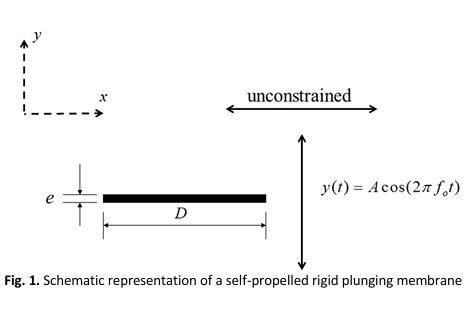Floquet Analysis and Symmetry Breaking Flow Patterns of a Thin Plunging Rectangular Plate
DOI:
https://doi.org/10.37934/sej.9.1.5475Keywords:
Lattice Boltzmann method, Floquet analysis, plunging, instability, self-propulsionAbstract
The present study focuses on the development of a numerical framework for predicting the horizontal movement of a vertically plunging plate due to symmetry breaking in the flow, mimicking the flight of a flapping insect wing. The wing is represented as a thin, rigid rectangular plate plunging in a quiescent fluid. Numerical simulations are performed on the unconstrained plunging rectangular plate (i.e., free to propel along a direction orthogonal to the plunging direction) by utilizing a translating continuous-grid-block and multiple-relaxation time variant of the lattice Boltzmann method. The onset of asymmetry is identified by the critical values of non-dimensional amplitude (represented by Keulegan-Carpenter number, KC) and frequency (or Stokes number,) and thickness to chord ratio (δ). The flow asymmetry that leads to self-propulsion is assessed by formulating an eigenvalue problem using Floquet analysis. It is shown that conditions for which propulsion initiates can be identified in a time-effective manner using the developed Floquet framework rather than a rigorous binary search-based method. Our analysis shows that the transition boundary in KC- space shifts to smaller KC for given as δ is reduced, suggesting that breaking of symmetry is readily achieved for a plate with lower δ. Furthermore, we report four distinct trajectories of the plate that depend on the combination of KC and . While the plate exhibits unidirectional propulsion for large , oscillatory motion is observed when KC >2 and <20. These kinematics are further differentiated using flow patterns associated with the plunging plate during propulsion and the phase-portraits of the coefficient of horizontal thrust. By probing the effect of ground clearance (ς) on the propulsion of the plate, it is shown that the shed vortices from the plate reflect from the nearby wall and reduce the effective circulation around the plunging plate leading to a delay in onset of instability. Meanwhile, lack of this plate-wake interaction results in flow asymmetry being observed much earlier for a plate that is far away from the stationary wall.










